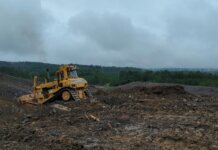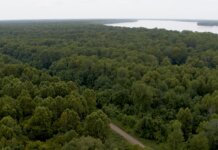Did you know that trees from Alabama may be keeping the lights on at Buckingham Palace?
Wood pellets from Alabama and a lot of other Southern states are being shipped to Europe. The United Kingdom is the biggest consumer of them all — almost exclusively for the purpose of producing electricity under alternative energy mandates set forth in the Kyoto Protocol, says Ken Muehlenfeld, director, Forest Products Development Center at AIDT (Alabama Industrial Development Training).
“There’s still a lot of growth expected in the European market, and they’ve got a long way to go to meet those renewable targets they’ve got in place, ” Muehlenfeld says. “I anticipate a lot more mills will be built to supply that market and beyond that. Right now the speculation is that Japan and Korea are following suit. It’s already developing to a small extent with some Canadian producers coming on board, but it could also be another market for Southern pellets.
“There’s a lot of growth left in the pellet industry, and I expect to see a number of more plants in the South.”
Wood pellets are not entirely new in the state, but the growth in recent years is noticeable.
In Reform, there’s Nature’s Earth, a small facility that’s been around 10 years or so, Muehlenfeld says. Nature’s Earth was the first company in Alabama to use residue and shavings out of sawmills, he says. They produce about 40, 000 tons of products each year.
“From cat litter for the pet market, to bag products for residential heating stoves and even horse bedding products, they create diversified and high-value products,” Muehlenfeld says.
He says Lee Energy Solutions in North Alabama produces about 125, 000 tons of pellets each year, mainly for furnaces to heat chicken houses. But the company also has overseas contracts.
Also in West Alabama is Westervelt Renewable Energy LLC, a renewable energy project developer and operator in Pickens County. The company began construction of a wood pellet facility in Aliceville in January 2012. Pellet production started in April 2013 for the Europe market. Muehlenfeld says they produce about 275, 000 tons of pellets each year.
In Selma, Zilkha Biomass bought the failed Dixie Pellets plant out of bankruptcy in 2010. The plant is expected to begin operation in early 2015 and should produce about 275, 000 tons of pellets each year, says Muehlenfeld.
The Selma operation will become the world’s first full-scale plant to produce Zilkha Black Pellets, which are an environmentally sustainable and low carbon fuel that can be transported and burned by coal plants using their existing equipment.
What will wood pellet production do to Southern timber?
Muehlenfeld says at the present time, Alabama is growing about 38 percent more timber than it’s harvesting.
“We’ve been building inventory, and every time we do a timber inventory we have more than we had last time,” Muehlenfeld says. “It’s not a situation of concern at the present time, because we have a lot of excess timber on sustainable basis.”
Wood chip mill owners are very conscious of supply when they consider a plant site, Muehlenfeld says, and his office tries “to look very thoroughly and make strong recommendations regarding resources and competition and sustainability of resources.”
The plants in Europe are sensitive to sustainability. Muehlenfeld says they have to document the wood they use is renewable and sustainable on a long term basis and to make sure it complies with all of the standards to make it as green as it can be.
“We’re not really in any danger of depleting the resource at the present time,” Muehlenfeld says. “There’s room for expansion of pellets and other industries.”
Wendy Reeves is a freelance writer for Business Alabama. She lives in Huntsville.



